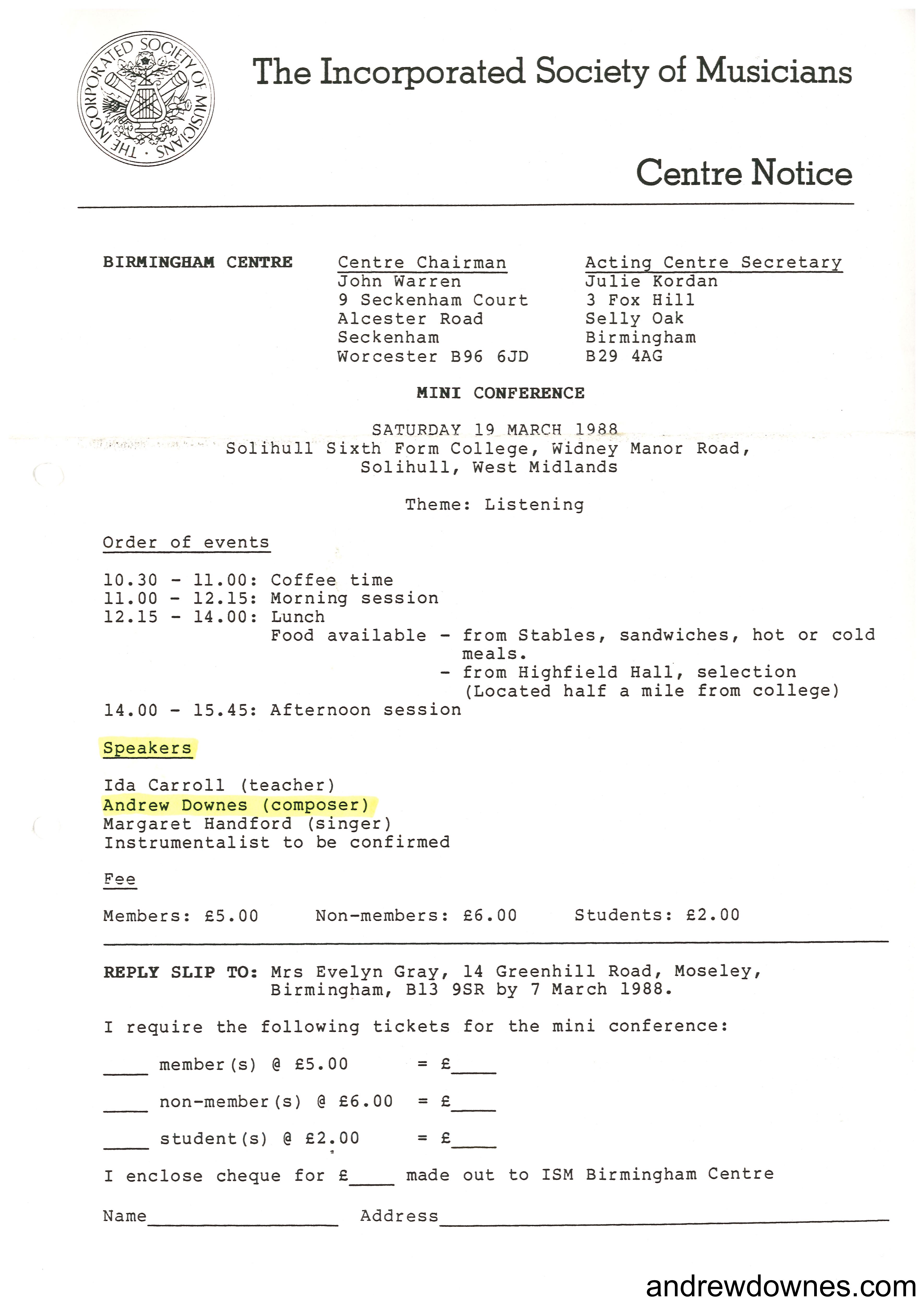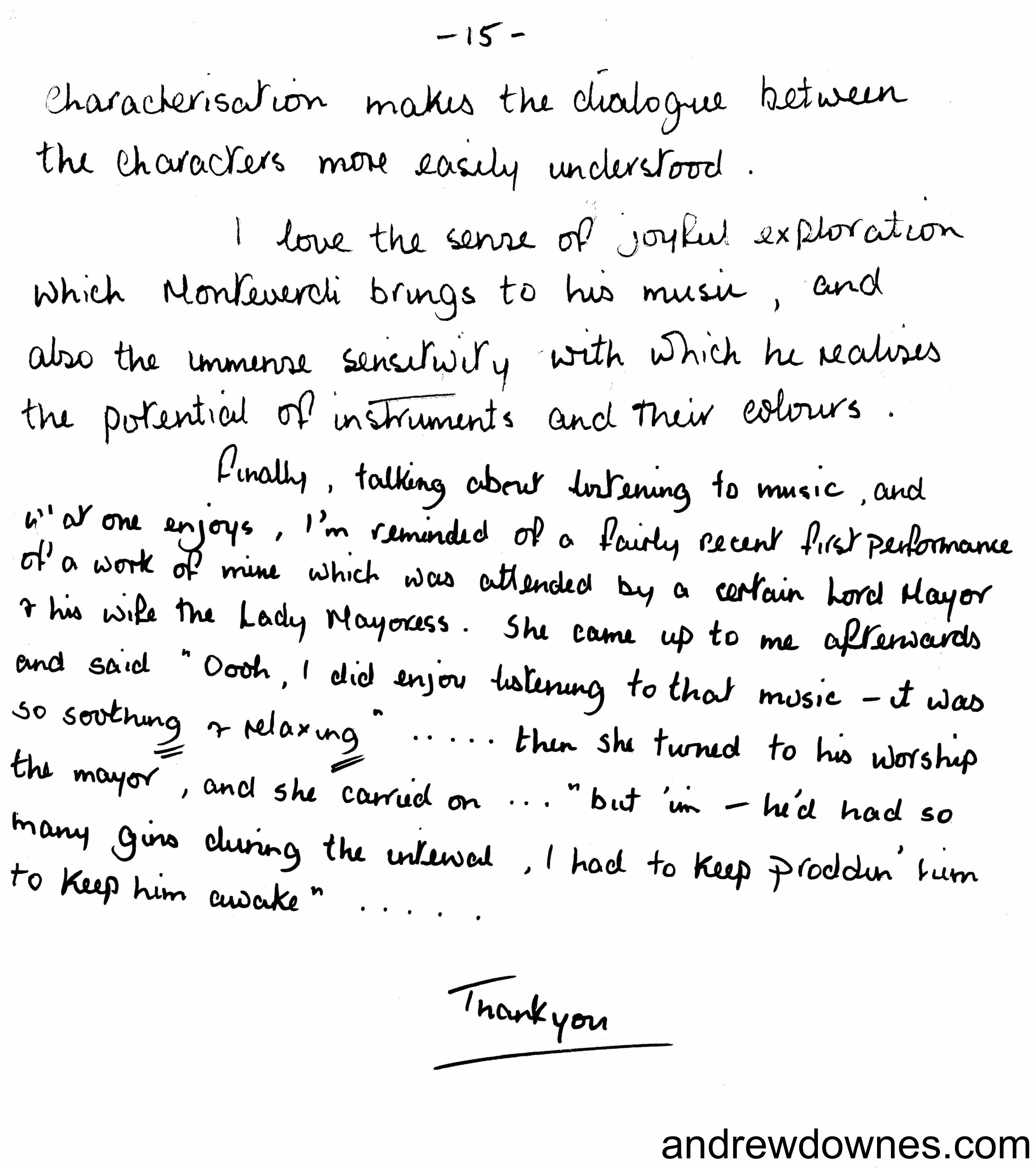Andrew Downes' ISM Conference Talk On "Listening", 1988
Follow Cynthia Downes on Instagram to keep up-to-date with her blog posts.
“LISTENING” from the point of view of a composer
Whilst I can only speak of my own experiences of listening to music, I think it is true to say that many composers listen to music in a way which would surprise most people. I think people imagine that a composer, as the creator of music, would listen out for structure and inner processes involved in the music in a keenly analytical way, and that tuning, perfection of balance and other critical aspects of a good performance are essential for a composer to enjoy a performance, particularly of his own music. I think, in fact, that people confuse the composer’s outer listening ear with his inner, intangible, imagining ear, and that in order to fully appreciate a performance, that performance must be of a high musical and technical excellence.
Nothing in fact, I think, could be further from the truth. Of all musicians the composer perhaps needs excellence in performance least in order to enjoy a work. A composer, through the nature and experience of his work, has developed his inner, imagining ear to such a state of keenness and inner awareness that his imagination is able to substitute sounds and accuracies which may be lacking in the performance. Last week, for example, I went to the Worcester Music Festival where my daughter was both singing in her school choir and playing in a recorder group.
I sat in the audience for the choral section and talked, as one does to the people around. All were discussing the various technical features which were either present or lacking in each choir, and each person, as is always the case, had a completely different set of criteria upon which they judged. Some were most concerned with diction, others with balance and ensemble. This latter, however, is surely a matter of preference rather than judgement. If you take the two great choirs in Cambridge, for example, does one prefer the perfection of blend, balance and ensemble which King’s offers, or is the approach of St John’s Choir with its more full blooded continental sound with individual voices allowed to shine through the texture, a preferable choral sound? I know that I prefer the latter, but just as many people prefer Kings and I am more than willing to admit that their view has equal validity with mine.
To get back to the Choir section of the Worcester Festival, the judge himself, a man who I know very well, and admire and respect greatly, fastened on intonation as being the chief general fault affecting nearly all choirs. Now he was quite right of course, to highlight this fault in a competitive situation. It is also right to point out that certain of the world’s great performers have used so called “bad tuning” to great effect. The great tenor Jussi Bjorling invariably sang sharp at moments of emotional climax, and this was a deliberate attempt on his part, successful in my view, to increase the tension and excitement of the performance. Dietrich Fischer-Dieskau is not averse to using the same sort of technique in tense exciting songs like “Erlkönig” and in his recording of Beethoven’s “Fidelio”. Even the great Dame Janet herself has been known to sing calculatingly sharp at moments of climactic excitement.
So in my view so called slight intonation variability in performance is not necessarily a bad thing and if handled skillfully and carefully can actually greatly enhance a performance. In fact as a composer one is often tempted to write such things into the score, but on the whole I think this is one of the performance parameters best left to the individual artist.
Once again to get back to the choir section of the Worcester Festival, I listened to the choirs in the same way as I listen to any music. I tried to discern what the emotional message of the music was and whether each choir brought it out successfully.
Perhaps I’ve got that wrong. I think rather than having any preconceived idea as to the meaning and feelings behind the music, I tried to listen to each choir with an open mind and hear what new feelings and emotions they found within the sounds of the music.
What I am saying, in effect, is that composers tend to listen to music in order to experience emotion and to find out what feelings each performer is able to recreate from the music. This is not in any way a dry analytical approach, but rather the opposite – it is to do with joy and death and love and the meaning of life and all those great intangibles and imponderables which cannot be expressed in any other known way than through pure, abstract sound.
As a composer, I often prefer to listen to performances of all kinds of music from plainsong to reggae and jazz given by the lesser known performers in our society. Groups of youthful performers are often the most exciting and invigorating to listen to because they are recreating music perhaps for the first time and they sense in it and feel in it things which perhaps have not been experienced before from that music. Also the very struggle involved in performing music which is perhaps at the boundary or even slightly beyond the boundary of their techniques often creates an excitement and a sense of striving and achievement which one rarely hears in performances given by the established orchestras or choirs.
As an example of this I compare performances of two different 20thCentury works given by two different orchestras. As an adviser to West Midlands Arts I am asked to go along to different concerts sponsored by them and to make comments as to whether their money is well spent or not. In this capacity I recently went to a performance of Vaughan Williams Symphony No. 5, a work which I adore incidentally, given by one of the world’s great orchestras. I also went to a performance of Shostakovitch’s Symphony No. 5 given by the Keele University Orchestra.
In the case of the Vaughan Williams, the performance was extremely polished, beautifully balanced and secure in all parts, but to my ears extremely dull and predictable – I’d heard it all before, and so had the orchestra. They seemed to have nothing vigorous or fresh to say about the work at all. None of the inner profound beauty of this wonderful piece came across and the whole effect was that of a mechanical and technical exercise. Indeed, using modern technology, a performance equal to its emotional impact could probably have been realised by electronic machines.
The Shostakovitch, on the other hand, given by Keele University Orchestra, was a performance of originality and youthful vigour. The lack of complete technical expertise amongst players actually gave, to my ears, a tension, a sense of struggle, and a thrill which was completely lacking in the performance of the Vaughan Williams. Much of the inner profoundity and depth inherent in the music came through in this rough and imperfect performance, and there was a sense of great emotional conflict and of immense achievement. As a composer, these are perhaps the things which one is listening for, so you have probably gathered that I enjoyed the Shostakovitch far more than the Vaughan Williams even though professional critics would probably pour scorn on this evaluation.
As a composer one likes to identifty with other composers of past and present, and in listening to their music one tries to discern whether the inner creation of the music are similar to those of one’s own efforts. As far as I’m concerned it is the sound of the music which matters, not what it looks like on paper. Indeed the score, to me, can get in the way of direct communication of emotion from the composer to the listener, and so when listening to music I rarely follow a score.
Indeed I think, as a composer, too much study and analysis of other people’s scores can be very dangerous, because in my view the very necessary influence which one generation has on the next generations of composers should be of a general, emotional and universal nature and should not be concerned with particular techniques and methods of composition. Indeed, in order to achieve individuality of expression each composer must struggle to find his own ways of depicting his inner feelings through sound.
In order to follow through the development and inner struggles of a particular composer I like to listen, if possible in the dark or with my eyes closed, to the complete output of that composer in the chosen medium. Of course, the Haydn Symphonies are somewhat difficult to get into a single sitting, but the symphonies of Beethoven or Sibelius are reasonably easy to fit into a free day, if one ever has one. As a student I used to do this quite often, and this of course gives credence to the widely held view that Oxford and Cambridge students lead a life of some leisure!
In the beautiful 1stSymphony of Beethoven I like to imagine the struggles and difficulties which he encountered in trying to fit his big, rough and deeply profound personality into the styles and forms and structures and sometimes foppish procedures of the 18thCentury. In the Eroica Symphony I like to imagine that immense emotional energy bursting out and creating unique and enormous sound landscapes. I also try to feel the tremendous joy and vitality inherent in the music, and this despite the dreadful condition in which the composer found himself at around the time of its composition. In the 5thSymphony I try to experience the rough almost macho energy of the music and again the triumph of joy over adversity in the final movement. In the 6ththe sense of wonder and peace one experiences as one travels through Beethoven’s imaginery pastoral landscape. And in the 9ththe immensity, the vastness, the sense of spiritual wonderment and the feeling of belonging to an unending and timeless universe.
Whilst the Symphonies of Beethoven are outgoing and are generally expressing joy, triumph and a sense of optimism and freedom, I always feel that the late string quartets, particularly opus 131 in C# minor are almost painfully inward looking and are involved in an exploration of the composers profound and tempestuous psychology. As with lots of other introverted music such as Tchaikovsky’s Pathetique Symphony, or much of the music of Elgar, I do have to be in the right mood in order to be able to bear some of the deep inner tension and the depressive inward looking feelings which the composer is attempting to express.
One category of music which I love listening to above all, and which perhaps has had most influence on my own music, is plainsong and the various forms of music which grew out of it. I love the smooth timeless quality of plainsong and its deep, inner spirituality. As one listens to it one feels at peace both with God and with nature. Its freedom from rigidity of rhythm I find most appealing and its expressive and beautiful word painting. For me there is no more wonderful experience than to visit one of the many monasteries of Normandy and to become involved in the sound of Gregorian Plainsong sung by the monks.
Of all composed music I think the works of Palestrina come closest to my ideal of beauty in sound and experience. Palestrina’s individual vocal lines come as close to the flow and freedom of plainsong as it’s possible to get in structure composed music. The smoothness of the part-writing, the stepwise movement of the melody and the way in which Palestrina almost invariably composes his parts within the comfortable tessitura of each voice part all contribute to the feeling of ease and freedom and joy which I experience in the music. The simplicity and perfect balance of the harmony and the symmetry of the counterpoint all add to this general feeling of well-being. No composer has given me more pleasure, either as a performer or listener than Palestrina.
Another aspect of music which I particularly listen out for, and which again, I think, has influenced me as a composer, is the contrast and beauty of orchestral and choral colours achieved by some composers. Composers with a keen sensitivity to orchestral colour include, obviously, the great Romantics such as Brahms, Dvorak and Wagner, and the Impressionists such as Debussy and Ravel. For me, however, these composers, and I particularly think of Elgar in this instance, although I do love much of his music, seem constrained in their exploration of orchestral colour by the Symphony Orchestra with its set number of particular instrumental categories for which they almost invariably composed. Obviously there are variations in the number of any particular instrument used by each composer for any particular piece, but the general overall structure of the orchestra is nearly always the same. In addition to this, particular attributes seem to have been assigned to various parts of the orchestra so that the brass are assumed to be the drama creators, the woodwind the colour givers and the strings are supposed to provide an overall cushion of texture upon which these other aspects are imposed. Many of these composers seem to have their strings playing nearly all the time, and this to me seriously restricts the possibilities of colour contrast within a piece of music. Mahler, to a certain extent, gets round it by treating his orchestra as a vast chamber ensemble so that different instrumental colours and soloistic features emerge quite regularly, and he has quite long passages where the strings aren’t playing at all. Sibelius solves the situation by writing often in instrumental blocks so that you have a block of string colour followed by a block of pure brass, and then maybe a section of woodwind alone, and he only brings the full orchestra together for climactic points.
However, before the development of the format for the modern symphony orchestra composers were much freer it seems to me to express sound colours in a much more individual and adventurous way. There seems to be much more flexibility and possibility of contrast in say Bach’s orchestration where you might get an aria supported by one or two instruments with continuo followed by a large chorus accompanied by full orchestra, followed by a section for unaccompanied choir and then perhaps another aria for a different voice with a different accompaniment.
One composer who perhaps represents great freedom in terms of orchestral colour and contrast is Monteverdi. I love listening to his music, partly because of its sense of newness, freshness and buoyancy, it being that thin dividing line between Renaissance and Baroque, but mainly I think because of its sense of freedom and adventurous experiment in orchestral and choral textures and colours. Particularly in his works of the first decade of the 17thCentury, Monteverdi explores all sorts of different possibilities and combinations with regard to techniques of orchestration. At this time no regular orchestral set up had been established, so Monteverdi was free to do what he liked in terms of what instruments he used and in what combinations he used them. In Orfeo of 1607 we get a large and diverse number of instruments, each playing its essential part in the dramatic development of the work.
Monteverdi divides his orchestra into what can be called foundation and ornament instruments. The foundation group, forming the basis I suppose of what was later to become the continuo, is responsible for the playing and harmonization of the bass parts and includes the lute, the chitarrone, the harp, the harpsichord, virginals, organ and regal. The ornament instruments are the wind, the strings and the lutes when they are not required as foundation instruments. Monteverdi allots the two worlds of his opera, that of the shepherds in Thrace and the realm of the underworld to two fundamentally different groups of instruments. Flutes, strings and plucked instruments are for the pastoral sphere and the cornets, trombones and regal for the underworld. Certain characters are given particular instrumental sounds as accompaniments so that a form of sound charactersisation makes the dialogue between the characters more easily understood.
I love the sense of joyful exploration which Monteverdi brings to his music, and also the immense sensitivity with which he realises the potential of instruments and their colours.
Finally, talking about listening to music, and what one enjoys, I’m reminded of a fairly recent first performance of a work of mine which was attended by a certain Lord Mayor and his wife the Lady Mayoress. She came up to me afterwards and said “Ooh, I did enjoy listening to that music – it was so soothing and relaxing” ….. Then she turned to his worship the mayor, and she carried on … “ but ‘im – he’d had so many gins during the interval, I had to keep proddin’ him to keep him awake” …..
Thank you
A sample of Andrew Downes' handwritten talk
Return to 'About Andrew Downes'
If you have performed in any of Andrew Downes' works or come to listen, please share your experiences in the Premieres Blog! Also see what others have said. Thank you so much for your contribution.





